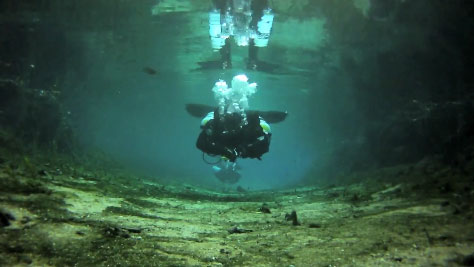The Mastery of Cave Diving22 December 2010  Curt and I spent last weekend diving with Josh Bernstein and sharing with him our views on sidemount cave diving and giving him some tips on technique. As much as I was excited to do so, I will still nervous – I am not an instructor, nor do I aspire to be one. Our "group" has always focused on mentoring and passing on lessons learned, gear configuration ideas and pretty much anything that would make each other better divers and explorers, but these dives were a little different. Albeit, Josh is an accomplished explorer in his own right, he is still new to sidemount cave diving and above all, a newcomer to our "group" – a very welcomed newcomer. Curt and I spent last weekend diving with Josh Bernstein and sharing with him our views on sidemount cave diving and giving him some tips on technique. As much as I was excited to do so, I will still nervous – I am not an instructor, nor do I aspire to be one. Our "group" has always focused on mentoring and passing on lessons learned, gear configuration ideas and pretty much anything that would make each other better divers and explorers, but these dives were a little different. Albeit, Josh is an accomplished explorer in his own right, he is still new to sidemount cave diving and above all, a newcomer to our "group" – a very welcomed newcomer.I have spent the past few months getting to know Josh and trying to convince him to do some cave exploration with us in the Dominican Republic, unfortunately our schedules never meshed. However, he will be joining us on our trip to Mexico as an explorer – he will be on rope and in the caves. That pretty much set up the reason for him to come to Florida and learn sidemount cave diving. Our group rarely dives anything other than sidemount on expedition as the terrain logistically doesn't support humping doubles through the jungle (nor do most of the caves we discover). We thought we would get Josh settled into his newly fit Armadillo Sidemount Exploration Harness and introduce him to Florida caves by visiting Ginnie Springs. Nothing like a little flow to contrast the still water of most Mexican caves! Josh's buoyancy and trim were spot on. Although the Armadillo rig is built to provide this, usually new sidemount divers take a little while to dial it in. The tasks that now lie ahead for Josh are hose routing, experience and comfort. The mastery of this is critical to being a successful sidemount cave diver. Working with Josh and watching Doug Mudry teach a GUE Fundamentals class, made me think about what it is we do and why it is that we do it. For some, cave diving is a recreational sport, for others it is a way of life (I am part of the latter group). Doug's students looked amazing in the water: trim, buoyancy, etc. That is the hallmark of GUE training – they look good in the water. These are critical initial skills any cave diver must learn, but new skills must be added as the caves dictate. Hence, Josh expanding his skills by adding sidemount cave diving. Many times we are in cave systems that don't allow you to look good in the water. The byproduct of digging and scraping is seeing caves that very few people ever have or no one ever has! I think one of my personal mottoes sums this up nicely – "If you don't go, you won't know". In my opinion, you must be able to master many skills and several types of diving in order to be ready to explore anything. Our group is comprised of like-minded and like-skilled explorers. We all cave, cave dive and climb, we also all backmount, sidemout, nomount and use rebreathers. In addition, we are always in pursuit of mastering each of these skills as you never know what type of equipment a newly discovered cave is going to dictate to you. Josh and I talked about mastery a few times. The last time we discussed mastery was walking back from Jug Hole and talked about how impressed I was by his dogged approach at a particular sidemount skill known as "supermanning". Supermanning is swimming while holding both tanks in front of you while the neck of the tank is still attached. A critical skill that is important for passing very small cave restrictions. Josh told me he wanted to master that skill as he does all skills, but this one in particular. He will tell you he is working on it; I will tell you he's mastered it. Mastery of your skills is a must, but you also must learn self-mastery. Cave diving and most importantly exploring and discovering new caves, can sometimes present threatening or challenging situations. Because of this, you must master your emotions and how your body reacts to these situations, just as you have mastered your skills. There are 5 basic rules of cave diving that were developed as a result of accident analysis and presented in Sheck Exley's Blueprint for Survival but I believe there is a 6th unwritten rule – "You panic, you die!". When you find yourself in a threatening or challenging situation never let your adrenaline takeover, remain calm and most importantly think! Fallback on the skills you have already mastered: your training, your skills and your gear. Many people will say they are afraid of dying, I am afraid of not living! Whatever your passion, don't just be good at it – MASTER IT! |
Recent Posts
Archives
|
